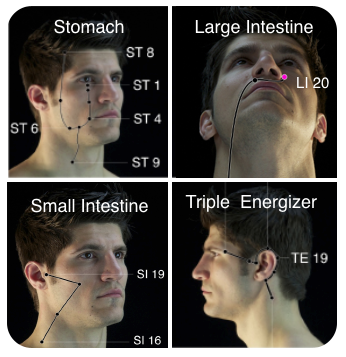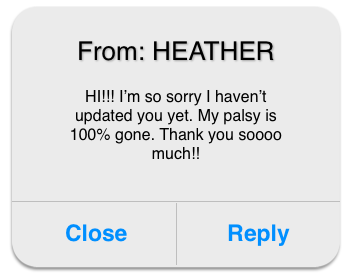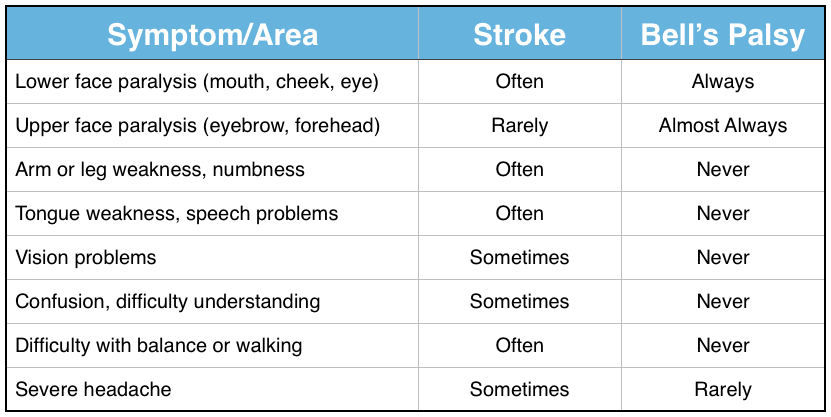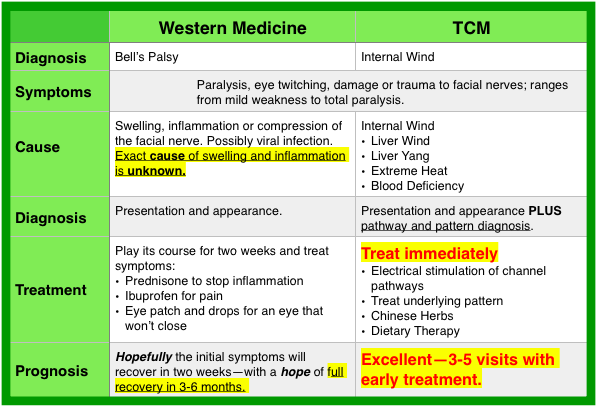I have a great story you are going to want to share with your patients. It involves Bell’s Palsy, a pregnant woman, AcuGraph, Auriculotherapy and this awesome text message:
Questions:
- Have you treated Bell’s Palsy in your clinic?
- Do you get great results?
- Have you educated your patients and community to call you IMMEDIATELY if they (or anyone they know) has a Bell’s Palsy attack?
There’s no way to know when someone is going to wake up with a Bell’s Palsy attack. Here’s what I do know… Most patients panic at the onset. It’s traumatic waking up in the morning with loss of function on one side of the face. The best way to deal with a traumatic situation is education and having the right resources.
Today’s blog is about educating your patients and giving them resources. YOU, the acupuncturist, are the perfect resource!
In a couple of days I’ll send you a follow-up Case Study–including graph analysis, treatment strategies, and before/after pictures of Heather, my pregnant patient who DID NOT panic when she woke up with Bell’s Palsy. She had already been educated regarding acupuncture. Instead of panicking, she made the best choice possible and called her acupuncturist right away.
Differential Diagnosis:
The first and most important step in differential diagnosis of Bell’s Palsy is to ensure your patient is not having a stroke, which is an emergency condition requiring immediate medical intervention. The following chart gives quick reference points to help differentiate between the two conditions:
**********
Once you’ve ruled out stroke, you can proceed with Bell’s Palsy treatment. Of course, this condition is commonly also seen in a Western medical setting. So what’s the difference between Western Medicine and Traditional Chinese Medicine (TCM), when it comes to Bell’s Palsy?
Interesting statistic:
This condition seems to be more common in patients ranging between the ages of 15 and 60 and in those with diabetes and/or upper respiratory ailments such as flu/cold.
How acupuncturists think differently:
Diagnosis:
An acupuncturist will not only look at the presenting symptoms on the face, involving the facial nerve; but will also look at other underlying “patterns” and energetic blockages in the acupuncture channels to determine what led to the Bell’s Palsy attack. Patterns are determined by asking questions that may not seem related to the present symptoms; but indeed help the acupuncturist know how best to resolve the problem. Palpation and measurements of electrical skin resistance in the channel will also help the practitioner determine underlying causative factors. *Common TCM Patterns are listed in the chart above.
Along with questions, palpation and measurements of electrical skin resistance, your practitioner may also feel your pulses and look at your tongue to determine the correct diagnosis.
Pattern Analysis:
Wind is the pattern that presents for Bell’s Palsy.
The Practical Dictionary of Chinese Medicine describes wind as follows:
- Wind is the natural movement of air. It “comes and goes quickly, moves swiftly, and blows intermittently.”
- Wind becomes problematic when its onset is swift–leading to convulsions, tremors, shaking of the head, dizziness, and wandering pain and itching.
- Wind invades the upper part of the body and exterior, especially the head; the lung; and the skin.
Wind causes facial paralysis. This may seem odd, because we just described wind as wandering and moving. In the case of facial paralysis, internal wind is actually blocking movement.
Wind in relation to Bell’s Palsy is called: Wind-Induced Deviation. The treatment strategies include resolving wind and moving blocked energy in the affected channels.
*It’s interesting to note that common TCM patterns in type II diabetes and upper respiratory tract infections include Liver Qi Stagnation and Heat. Liver Qi Stagnation, if left unchecked, eventually leads to a Wind condition. Upper respiratory ailments are considered Wind Cold and Wind Heat attacks, according to TCM.
Channel Diagnosis:
Multiple acupuncture channels run through the face. Specific channels that affect Bell’s Palsy include the Stomach, Large Intestine, Small Intestine, and the Triple Energizer.
 When internal wind creates blockages in these particular channels, acupuncturists often find great results using electrical stimulation. My personal experience shows that if treatment is done early, five visits are usually sufficient to resolve symptoms of Bell’s Palsy.
When internal wind creates blockages in these particular channels, acupuncturists often find great results using electrical stimulation. My personal experience shows that if treatment is done early, five visits are usually sufficient to resolve symptoms of Bell’s Palsy.
Problem:
The band aid approach offered through Western medicine works for some. This is why Western medicine has deemed Bell’s Palsy to disappear on its own in many cases. In my opinion, taking the “wait and see” approach is risky. Why risk having symptoms at the end–when you could have tried TCM. It’s proven to work.
I can’t tell you how many people I’ve met over the years that call me months to years after a Bell’s Palsy attack, asking if acupuncture can help. First, they waited the initial two weeks suggested by the Western MD to see if the symptoms would resolve; then they continued to wait the extended 3-6 month recovery time.
What was the result? Unfortunately, they didn’t receive the “hoped for” full recovery presumed by their Western doctors. Obviously, no one had educated them regarding the benefits of acupuncture EARLY ON for Bell’s Palsy.
In order to get EXCELLENT results for Bell’s Palsy, it’s important to treat the underlying pattern and channel blockages, that only the acupuncturist understands, immediately! I like to teach my patients that the sooner they get in, the better their prognosis will be. I even keep myself available for same day and weekend treatment for Bell’s Palsy cases. Treating the underlying pattern and channel imbalances before treating symptom relief brings the best results.
About 40,000 people in the United States experience a Bell’s Palsy attack each year. Let’s teach them that acupuncture can help!
**********
You’re probably wondering what points I used and what my treatment strategies were. Keep reading, because I’ve got a great case study to share!
Enjoy!
Kimberly Thompson, L.Ac.
Acupuncture Research Analyst
Miridia Technology





I purchase the Acugraph Meridian Device. I am not an Acupuncturist, I would like to if there is any info or any chart that can let me know what imbalance is connected to the particular Meridians. I would appreciate any info you could send me as I am not working now!!
Thanks a Million
Peter
PS I will be sending you interesting info soon.